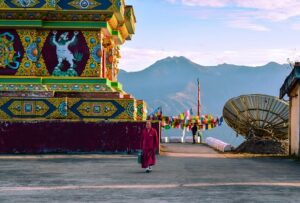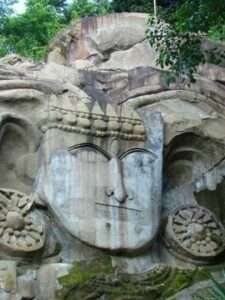Nestled in the heart of Sikkim, Yuksom is a small town with a big personality. Once the capital of Sikkim, it’s a charming blend of history, culture and stunning natural beauty. Whether you’re a nature lover, a history buff, or just looking for a peaceful retreat, Yuksom has something for everyone.
Here’s everything you need to know to make the most of your visit to this enchanting hill station.
Yuksom Travel Guide – Explore Sikkim’s Hidden Gem
Before getting to the travel guide, let us take a dip into the history of Yuksom.
A Glimpse into Yuksom’s History
Yuksom, meaning “meeting place of three monks,” has a rich historical significance. It’s where the first Chogyal (king) of Sikkim was crowned in 1642. You can still see remnants of the coronation stone in the town, a great spot to snap a photo and imagine what it must have been like back then.
The town is also a spiritual haven, with several monasteries and temples dotting the landscape. The Dubdi Monastery, which dates back to 1701, is a peaceful retreat and a must-visit for anyone looking to experience the spiritual side of Yuksom.
Yuksom Travel Guide – Things to Do in Yuksom
1. Trekking to Goecha La
For the adventurous types, the Goecha La trek is an absolute highlight. This challenging but rewarding trek takes you up to 16,000 feet, offering spectacular views of Kanchenjunga, the third-highest mountain in the world. The trek winds through dense forests, alpine meadows and rugged terrain, so be prepared to get your boots dirty. But the view from the top? Totally worth it.
2. Visit the Coronation Throne
Yuksom’s history is etched in the land. The Coronation Throne, also called Yuksom Coronation Stone, marks the spot where the first king of Sikkim was crowned. It’s a cool historical landmark that adds depth to your visit. You’ll find it just a short walk from the main market.
3. Explore the Khecheopalri Lake
About a 30-minute drive from Yuksom, this serene lake is a sacred site for both Buddhists and Hindus. Legend says that the lake’s waters are so pure that no leaves ever float on its surface. Whether you believe the myth or not, it’s a peaceful place to take a leisurely walk or enjoy a quiet moment of reflection. Plus, the surrounding forest is lush and full of vibrant birdlife.
4. Monasteries and Spiritual Vibes
Yuksom is dotted with monasteries, each offering a unique experience. Visit Khangchendzonga Monastery, which sits on a hill, offering sweeping views of the valley. The colours, prayer wheels and chanting monks create an atmosphere of peace and tranquillity that is perfect for unwinding.
5. Tea Gardens and Local Produce
If you’re a fan of tea, you’ll love Yuksom’s lush tea gardens. The town is surrounded by greenery, with a number of farms and orchards where you can pick up fresh produce. You can also learn about the local tea-making process and sample some of the freshest brews you’ve ever had.
6. Visit the Tashiding Monastery
The Tashiding Monastery is one of Sikkim’s holiest and most revered Buddhist sites. Located about 25 km from Yuksom, this monastery is perched on a hilltop and offers stunning views of the surrounding mountains and valleys. The monastery is known for its peaceful atmosphere and the Bumchu Festival, a unique event held every year, where a holy water pot is opened to predict the future of the region. It’s a great spot for history buffs and spiritual seekers alike.
7. Hike to the Sachen Monastery
If you’re looking for a less demanding trek, the Sachen Monastery is a great alternative. A moderate 3-hour hike will take you through scenic forests and small villages, ultimately leading you to the serene monastery. The views of the valley from here are breathtaking, making it a rewarding trek without being overly strenuous.
8. Explore the Yuksom Village
Sometimes, the best way to experience a place is by simply walking around. Yuksom’s village is a blend of traditional Sikkimese architecture and lush nature. Wander the narrow streets, interact with friendly locals and check out the local handicrafts and souvenirs. You can also visit the bustling Yuksom Market, where you can find everything from fresh produce to traditional clothes and spices.
9. Go for a Nature Walk in the Yuksom Forest
If you love the great outdoors, Yuksom is surrounded by lush forests that are perfect for nature walks. These forests are home to a variety of flora and fauna, including colourful birds, butterflies, and even the occasional wild boar. There are several easy-to-moderate trails that can lead you to hidden spots, providing a serene escape into nature.
10. River Activities in the Rangit River
If you’re into water sports, the Rangit River near Yuksom offers opportunities for white-water rafting. The river’s gentle rapids make it a fantastic option for beginners. It’s an exhilarating experience with stunning views of the surrounding mountains and valleys. For a more relaxed vibe, you can enjoy a peaceful boat ride along the river.
11. Visit the Khangchendzonga National Park
Yuksom lies at the doorstep of Khangchendzonga National Park, a UNESCO World Heritage site. For nature lovers and wildlife enthusiasts, a visit to this park is a must. The park is home to rare species like the snow leopard, red panda, and Himalayan tahr. You can also find alpine meadows and glacial lakes, and if you’re lucky, you might even catch a glimpse of the mighty Kanchenjunga.
12. Attend a Local Festival
Sikkim is known for its vibrant festivals, and Yuksom celebrates a number of them throughout the year. The Losoong Festival (Sikkimese New Year) and Bumchu Festival are especially celebrated in and around Yuksom. These festivals offer an opportunity to experience traditional Sikkimese dance, music and rituals, giving visitors a deeper cultural immersion.
13. Photography and Bird Watching
Yuksom and its surrounding areas offer fantastic opportunities for photography. Whether you’re capturing the snow-capped peaks of Kanchenjunga, the vibrant monasteries or the lush landscapes, it’s a photographer’s paradise. Bird watchers will also be in heaven, the region is home to over 500 species of birds, including the Himalayan griffon and the blood pheasant.
14. Experience Local Handicrafts
While in Yuksom, make sure to explore the local handicrafts. The town is known for its traditional handwoven textiles, carpets and wooden sculptures. You can visit local craft shops where artisans showcase their worksand it’s a great opportunity to buy authentic souvenirs to take home.
15. Enjoy a Bonfire Night
Many hotels and resorts in Yuksom offer bonfire nights, especially during the cooler months. These evenings are perfect for unwinding after a day of exploration. Sitting around a crackling fire, sipping on hot tea or local brew and sharing stories with fellow travellers is a wonderful way to experience the laid-back vibe of the town.
16. Take a Jeep Safari to Rinchenpong
Rinchenpong, about a 30-minute drive from Yuksom, is a peaceful village surrounded by orchards and forests, offering spectacular views of Kanchenjunga. It’s perfect for a jeep safari, where you can explore the nearby villages, catch panoramic views and immerse yourself in the local culture.
17. Relax and Unwind
Sometimes, the best activity is to just kick back and relax. Yuksom’s calm atmosphere and stunning surroundings make it an ideal place to disconnect from the hustle and bustle of daily life. You can simply enjoy a book, take a leisurely walk around town or meditate by the serene rivers and lakes.
Yuksom Travel Guide – When to Visit, How to Reach and Where to Stay
When to visit Yuksom?
The best time to visit Yuksom is during the spring (March to May) and autumn (September to November). During these seasons, the weather is perfect, neither too hot nor too cold. And you get the best views of the surrounding mountains.
Winter (December to February) brings a dusting of snow to the area, but the chilly temperatures can make trekking a bit harder. The monsoon season (June to August) is best avoided as it can get slippery and prone to landslides.
How to reach Yuksom
Yuksom is about 40 kilometres from Pelling, a popular town in Sikkim. You can reach Yuksom by jeep or shared taxi from Bagdogra Airport (about 160 km away) or from Siliguri, the nearest major city. The road from Pelling to Yuksom is quite scenic, with plenty of opportunities for stops along the way to take in the views.
Where to Stay
Yuksom offers a range of accommodations, from simple guesthouses to more luxurious options. The town’s calm vibe is reflected in the lodgings, with many places offering stunning mountain views and tranquil surroundings. Yuksom’s Tashiding Resort or Yuksom Farmstay are both great options if you’re looking for a peaceful place to relax and reconnect with nature.
Yuksom Travel Guide – Local Cuisine to explore
Sikkimese food is delicious and something you definitely don’t want to miss. Try some momo (dumplings), which are a favourite snack throughout the region or thukpa (noodle soup), a hearty dish perfect for chilly evenings. Yuksom also has several small eateries where you can sample authentic Sikkimese flavours.
Some Important Tips Along With The Yuksom Travel Guide
Permit
For trekking and visiting protected areas like Khangchendzonga National Park, you will need special permits, including an Inner Line Permit (ILP) for non-Indians and a Trekking Permit for specific treks. These can be obtained through travel agencies or at the District Magistrate’s office in Yuksom. Always check with your travel organiser to ensure you have the required permits.
Mobile Network
Mobile network coverage is available in Yuksom, but it can be patchy, especially in the more remote areas. BSNL and Airtel are the main providers. Wi-Fi is available in many hotels, but it may not be as fast as in urban areas, so it’s best to plan if you need reliable internet access
Packing
If you’re planning to trek, make sure to pack sturdy trekking shoes, warm clothes (even in warmer months), a good quality backpack and a rain jacket (especially in the monsoon season). For sightseeing and general exploration, casual clothes, a hat, sunscreen, and a camera are essentials. Also, don’t forget your personal medications, as medical facilities in remote areas can be limited.
ATMS
There are limited ATMs in Yuksom, so it’s a good idea to carry enough cash with you. ATMs may not always work or have a limited withdrawal amount, so it’s wise to withdraw cash in advance while you’re in larger towns like Pelling or Siliguri.
Accommodation
Yuksom offers a range of accommodations, from budget guesthouses to more upscale resorts and homestays. You’ll find options with beautiful views of the mountains and many places focus on eco-tourism. Some popular choices include Yuksom Tashiding Resort, Tashi Gang Resort and homestays that offer a more intimate experience.
Conclusion
Yuksom is the kind of place that stays with you long after you leave. With its historical charm, natural beauty and laid-back atmosphere, it’s a perfect blend of adventure and relaxation.
Yuksom offers more than just its main attractions, it’s a place where every moment feels like a new discovery.
Whether you’re here for the trek of a lifetime, the spiritual peace or just to enjoy some quiet time in the mountains, you’ll find plenty to love about this hidden gem in Sikkim.
Pack your bags and get ready to explore. Yuksom is waiting!
FAQs =》
Q1. Is Yuksom safe for solo travellers?
Ans. Yes, Yuksom is generally safe for solo travellers. It’s a small town with a calm and friendly atmosphere and the locals are welcoming. As with any destination, it’s essential to follow basic safety precautions, especially when trekking in remote areas.
Q2. Is there vegetarian food available in Yuksom?
Ans. Yes, Yuksom has several eateries that serve vegetarian food. Local Sikkimese cuisine, including momos (dumplings) and thukpa (noodle soup), is vegetarian-friendly, and most restaurants in the area will offer a range of vegetarian options, including North Indian and Chinese dishes.
Q3. Are there any nearby attractions worth visiting?
Ans. Yes. If you’re in Yuksom, there are several nearby attractions:
– Khecheopalri Lake – A sacred lake surrounded by lush forests, perfect for a peaceful visit.
– Tashiding Monastery – A spiritual and cultural highlight, offering amazing views and history.
– Pelling – A popular nearby town known for its views of Kanchenjunga and attractions like the Pemayangtse Monastery and Rabdentse Ruins.
– Khangchendzonga National Park – For wildlife enthusiasts and nature lovers.
Q4.What activities can I do in Yuksom besides trekking?
Ans. In addition to trekking, you can enjoy:
– Nature walks through the scenic forests surrounding the town.
– Photography of the stunning landscapes, monasteries, and local culture.
– Visit monasteries like Dubdi Monastery and Khangchendzonga Monastery.
– Bird watching and wildlife spotting, especially around Khangchendzonga National Park.
– River activities, including white-water rafting on the Rangit River.
Q5. Can I visit Yuksom in winter?
Ans. Yes. You can visit Yuksom in winter if you enjoy snow and a crisp atmosphere. However, the weather can get quite cold, especially at higher altitudes, so pack accordingly. Winter also makes for a great time for photography and snow activities, but be prepared for fewer services and limited transportation options due to snow.
Q6. Is Yuksom suitable for family vacations?
Ans. Yes, Yuksom is great for families looking for a peaceful getaway. With its beautiful natural surroundings, cultural landmarks and moderate trekking options, families can enjoy both adventure and relaxation in this serene town.


